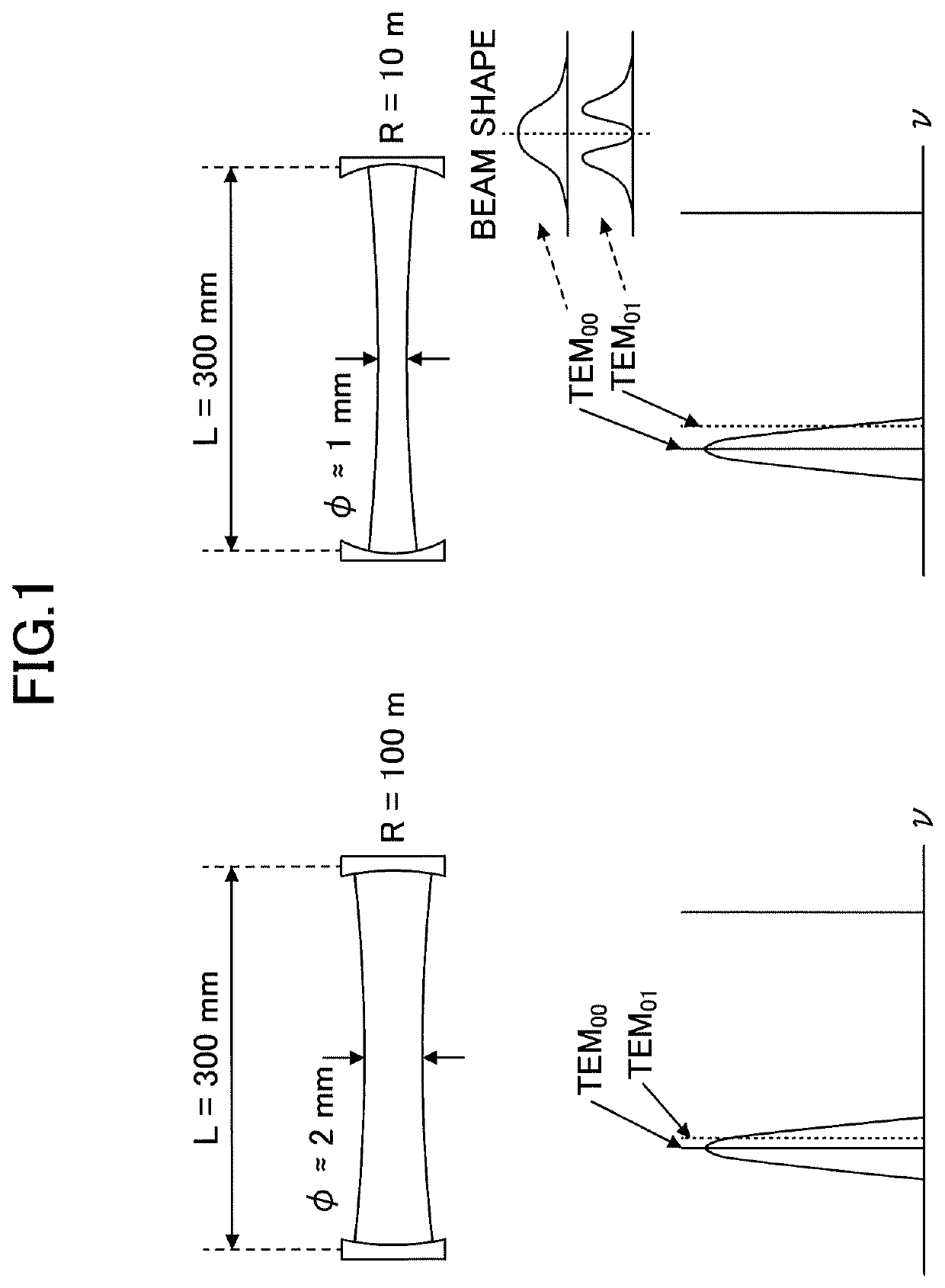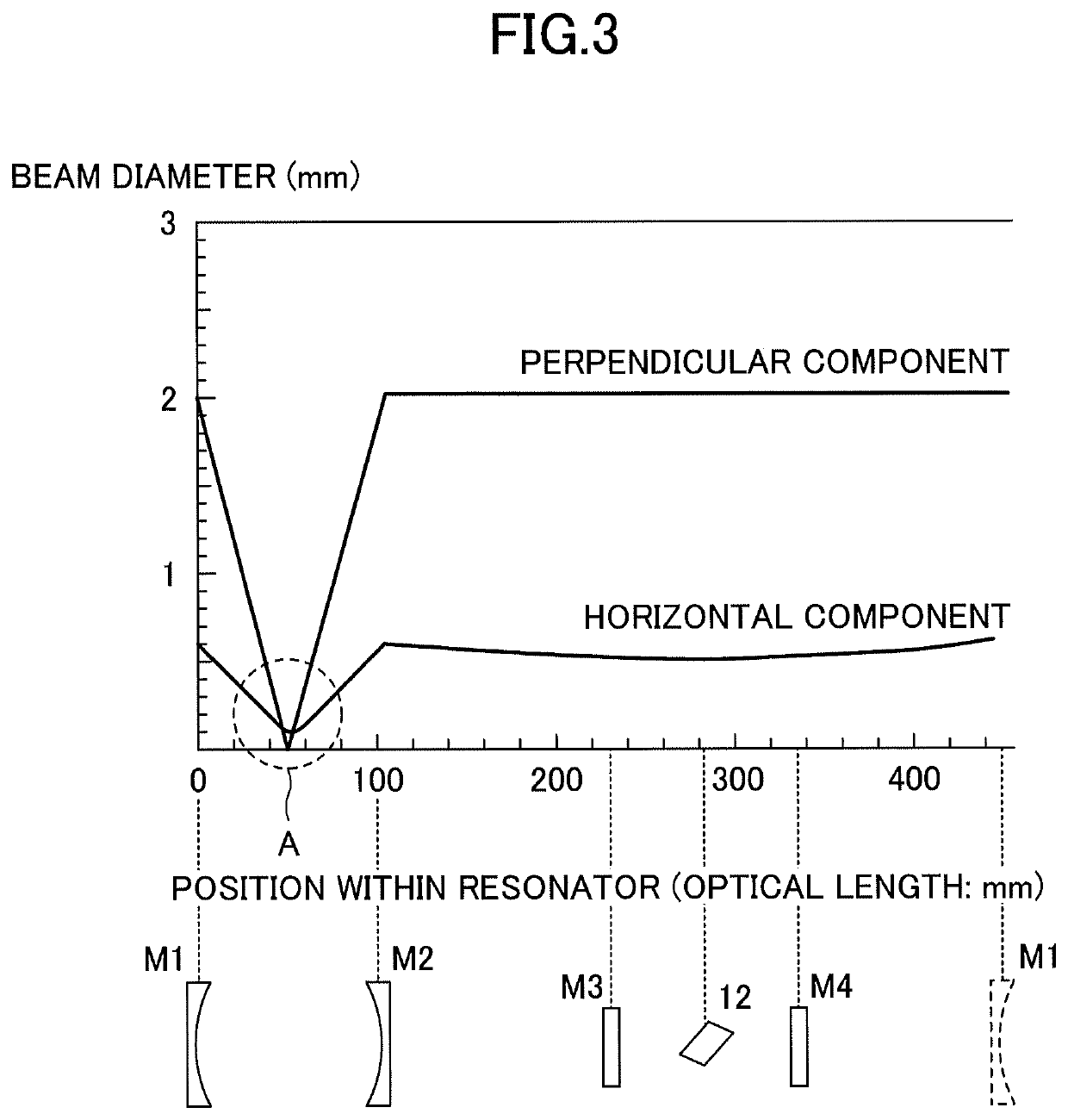Laser resonator, and method of designing laser resonator
a laser resonator and laser resonator technology, applied in the direction of laser details, optical resonator shape and construction, excitation process/apparatus, etc., can solve the problems of high-intensity light damage to optical elements or optical components forming the laser resonator, and it is difficult to obtain a single transverse mode laser output having a uniform section intensity distribution, so as to prevent optical damage to the resonator
- Summary
- Abstract
- Description
- Claims
- Application Information
AI Technical Summary
Benefits of technology
Problems solved by technology
Method used
Image
Examples
first modification
[0051]FIG. 7 is a diagram schematically illustrating a laser resonator 20 in a first modification. In FIG. 7, transparent plates 15 and 16, respectively satisfying a predetermined condition, are inserted in the path between the concave mirrors M1 and M2 having the curvature.
[0052]Generally, when spherical mirrors having curvature are used in the bow-tie or Z-type resonator arrangement, astigmatism occurs, the beam diameter becomes oval, and different beam divergences are generated along a major axis direction and a minor axis direction of the oval. Such different beam divergences may also be observed from FIG. 3 and FIG. 4. In order to reduce the effects of astigmatism, each of the transparent plates 15 and 16, forming an example of an astigmatism correction device or an astigmatism correction means, are inserted obliquely with respect to an optical axis. A correction amount of the astigmatism may be prescribed by a thickness t of the transparent plates 15 and 16, a refractive index...
second modification
[0054]FIG. 8 is a diagram schematically illustrating a laser resonator 30 in a second modification. The configurations illustrated in FIG. 2 and FIG. 6 increases the light confinement effect by the concave mirrors M1 and M2 having the actual curvature, and also arranges the laser medium 12 in the parallel light path in which the beam diameter is large, to avoid the optical damage to the optical element or the optical component and simultaneously maintain the single transverse mode oscillation. However, the tightly focused beam waist is formed within the laser resonators 10 and 10A, and air discharge may be generated at the beam waist when the high laser output is to be obtained.
[0055]In the second modification, the beam waist region is arranged in a vacuum environment, to prevent the air discharge. The laser resonator 30 includes the concave mirrors M1 and M2 having the curvature, the planar mirrors M3 and M4, and a vacuum cell 17 arranged at the beam waist region. Similarly as in t...
third modification
[0056]FIG. 9 is a diagram schematically illustrating a laser resonator 40 in a third modification. In the third modification, the vacuum cell of the second modification and the obliquely arranged transparent plates of the first modification are combined, to prevent both the astigmatism and the air discharge. The laser resonator 40 includes the concave mirrors M1 and M2 having the curvature, the planar mirrors M3 and M4, and a vacuum cell 18 arranged at the beam waist region. The vacuum cell 18 includes transparent plates 21 and 22, respectively arranged on an incidence side and an outgoing side, and inserted obliquely with respect to the optical axis. The transparent plates 21 and 22 reduces the astigmatism, and the vacuum cell 18 prevents the air discharge. By setting the angles of the transparent plates 21 and 22 that form optical windows of the vacuum cell 18 so as to satisfy the Brewster's condition, it is possible to prevent the reflection loss. Similarly as in the case of the ...
PUM
| Property | Measurement | Unit |
|---|---|---|
| diameter | aaaaa | aaaaa |
| diameter | aaaaa | aaaaa |
| diameter | aaaaa | aaaaa |
Abstract
Description
Claims
Application Information
 Login to View More
Login to View More - R&D
- Intellectual Property
- Life Sciences
- Materials
- Tech Scout
- Unparalleled Data Quality
- Higher Quality Content
- 60% Fewer Hallucinations
Browse by: Latest US Patents, China's latest patents, Technical Efficacy Thesaurus, Application Domain, Technology Topic, Popular Technical Reports.
© 2025 PatSnap. All rights reserved.Legal|Privacy policy|Modern Slavery Act Transparency Statement|Sitemap|About US| Contact US: help@patsnap.com



